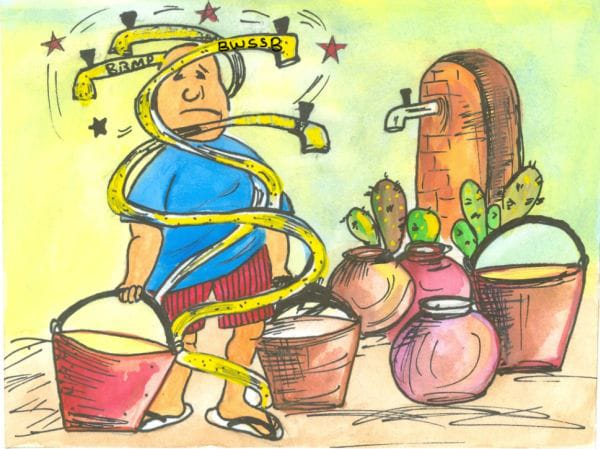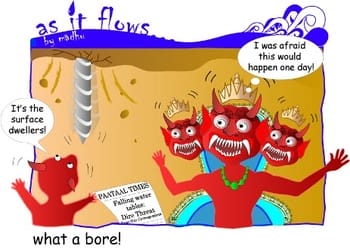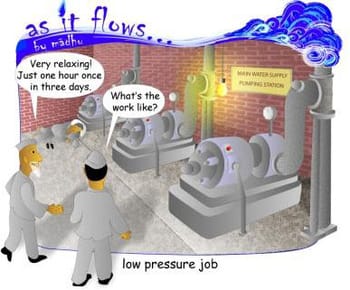“Don’t worry for water, Bangalore,” – a fortnight ago a news report ascribed the above assurance from the BWSSB and the Government. Nothing can be further from truth. Bangalore is facing a water calamity. The facts are given below.
GAP BETWEEN DEMAND AND SUPPLY WILL ONLY INCREASE
At the historical 4% population growth rate of Bangalore over the past fifty years, the population of Bangalore living in the 772 sq. km. of area under the present BBMP will increase from 85 lakhs in 2011 to one crore by 2016. With Hessarghatta gone and Tippegondahanally drying up, the only reliable water supply to Bangalore is from Cauvery with a gross of 1,410 MLD.

There is no way of increasing drawal from Cauvery as the allocation by the Cauvery Water Disputes Tribunal for the entire urban and rural population in Cauvery Basin in Karnataka is only 8.75 TMC. As one TMC (thousand million cubic feet) equals an annual supply of 78 ML per day, Bangalore city is already drawing more water, 1,400 MLD equals 18 TMC, than the allocation for the entire rural and urban population in Cauvery basin.
Bengaluru is not learning from the Fatehpur Sikhri disaster
- Bangalore city is already drawing more Cauvery water that allocated for the entire entire rural and urban population in Cauvery basin.
- An estimated 35% of BWSSB water is leaks from supply pipes. Plugging this leakage alone through schemes such as the “24/7 Supply” in Hubli-Dharwad, Gulbarga and Belgaum will save about two-thirds (25%) of the leakage.
- 600 lakes of Bangalore Urban district have all become Sewage Tanks
- 850 kms of old ‘Raja-Kaluves’ meant as Storm Water Drains to carry surplus water from higher elevation lakes to lower levels in a cascading system of natural rain water harvesting, now carry the city’s sewage instead to these lakes.
- The existing 14 Secondary Treatment Plants, 4 Tertiary Treatment Plants hardly treat 30% of the sewage because of the latter not flowing into the STPs (but into the lakes) and due to poor maintenance by contractors to save on electricity and lack of supervision.
- 52% of the borewell water and 59% of tap-water in Bangalore is not potable and carries threat of E.coli infections.
- Rainwater harvesting that presently covers only 44,000 houses out of some 18 lakh properties has no meaning.
Besides, Bangalore city falls under two basins, Cauvery and Pennaiyar basins. Only the Cauvery basin area can receive Cauvery Water and half of Bangalore is outside it. The schemes which the Government proposes – namely, diversion of water from West flowing rivers such as Kanganahole, Kakkatuhole and Ethinahole, bringing water from Almatti dam etc. – are flights of fantasy and can only result in contractors’ and their patrons’ dream projects and environmentalists’ nightmare.
About 43% of the water supplied by BWSSB is Non-Revenue Water or Unaccounted For Water (UfW) of which an estimated 35% is simply leakage from supply pipes. It costs Rs.300 crores annually in electricity charges to BWSSB currently to pump water from Cauvery. Therefore it spends Rs.100 crores annually to let water underground leading to the unintended consequence of increasing the dwindling water table!
Plugging this leakage alone through schemes such as the “24/7 Supply” in Hubli-Dharwad, Gulbarga and Belgaum will save about two-thirds (25%) of the leakage, equivalent to 125 MLD. At present, with nearly 500 MLD of leakage and another 150 MLD going to industries, the balance of 750 MLD for a population of one crore works out to 75 litres per capita per day while the Government of India norm for metropolitan cities is 150 Litre per Consumer per day. With Bangalore’s population going up every year, the gap between supply and demand will only widen with supply from Cauvery having reached the ceiling.
BOREWELLS SUPPLYING CONTAMINATED WATER
There are about 312,000 borewells in Bangalore which draw about 300 MLD. The drawal of underground water is 3.7 times more than the recharge from 900mm, Bangalore’s annual rainfall. This is the reason why the borewells have gone deeper upto 1,000 feet and many are becoming totally dry.
Moreover, the 600 lakes of Bangalore Urban district have all become Sewage Tanks as shown in Volume 2 of Excreta Matters by Centre for Science & Environment, Delhi, 2011 – a study of 71 cities in India. The sewage water contaminates the ground water and percolates into the borewells.
According to the laboratory results of the Public Health Institute and the Department of Mines & Geology, GoK, 52% of the borewell water and 59% of tap-water in Bangalore is not potable and contain 8.4% and 19% Eschericha coli bacteria respectively. When it gets infected, E.coli becomes a dire health hazard.
The problem of diseases from public and borewell drinking water in Bangalore is seldom highlighted.

Illustration: Madhu Ramaswamy, courtesy: IWP. File pic.
A CITY DIES WHEN ITS LAKES DIE
Of the original 927 lakes in Bangalore Urban District (according to the Revenue Records), less than 200 are said to be “live” lakes. Many of them have been breached and converted into layouts, bus-stations, golf clubs, stadiums, colleges, government offices, etc.
The “live” lakes that exist still are only storing the city’s sewage. The 850 kms of old ‘Raja-Kaluves’ meant as Storm Water Drains to carry surplus water from higher elevation lakes to lower levels in a cascading system of natural rain water harvesting, now carry the city’s sewage instead to these lakes.
The existing 14 secondary treatment plants, 4 tertiary treatment plants and 10 more STPs under construction will together have a capacity to treat 1,133 MLD. However, the existing STPs hardly treat 30% of the sewage because of the latter not flowing into the STPs (but into the lakes) and due to poor maintenance by contractors to save on electricity and lack of supervision.
If the STPs with huge investments already made are effectively used to treat the sewage and more are converted to TTPs, the recovered water can be re-used at least for non-potable purposes to start with. Unless the sewage is diverted and the Raja Kaluves are cleared of encroachments to carry surplus rainwater to the succession of lakes, all the water bodies in Bangalore will become sewage cess-pools causing immense health hazard.
Restoration of lakes done by BBMP with “soup-bowl” technology, decorative bird-islands, paved jogging paths and Chain Link Fences without attending to the primary task of diversion of sewage away from the lakes, helps only the contractors and their patrons.

Illustration: Madhu Ramaswamy, courtesy: IWP. File pic.
RAINWATER HARVESTING, A JOKE IN BANGALORE
Rainwater harvesting that presently covers only 44,000 houses out of some 18 lakh properties has no meaning. As only 40% of the area of Bangalore is covered by roofs, for rainwater harvesting to be effective, it should be done on a geographical basis covering the entire four basins of Bangalore as done in Singapore, a city that works. What is done in Bangalore now can only be termed sloganeering.
SOLUTIONS
Obviously these problems are gigantic but must be solved in an integrated and comprehensive manner if Bangalore has to survive. What the BWSSB is doing is tokenism, piece-meal, ad-hoc and on “pilot” basis. A comprehensive plan including all the above components with genuine restoration of lakes, leakage plugging, effective STPs and TTPs, Rainwater Harvesting and involving civil society organizations can alone solve the crisis facing Bangalore. It also requires a sizeable investment.
As part of an initiative by Bangalore Environment Trust and the Centre for Policies and Practice, we had requested a consultant to suggest an outline for a comprehensive plan. Their recommendation is shown below:
| ITEM OF WORK | AMOUNT IN Crores Rs. |
| 1. Reducing Leakages in 650,000 connections from 30% to 15% in core area from Source to House connections under Maintenance Contract system as in Hubli-Dharwad, Gulbarga and Belgaum | 1,250 |
| 2. Removal of encroachments & maintenance of 850 kms of SWDs and Raja-kaluwes with proper servicing tracks | 10,000 |
| 3. Rejuvenation of Lakes and maintenance | 5,000 |
| 4. Segregating sewage from SWDs, Optimum Treatment in STPs and TTPs, New STPs and Upgrading existing STPs including the major 300 MLD Vrishabavathy Valley STP and laying Dual Pipelines | 2,750 |
| 5. Rainwater Harvesting and other Miscellaneous Works | 5,000 |
| 6. Price and Physical Contingencies | 2,000 |
| TOTAL | 26,000 |
Such a comprehensive project will take about 10 years and can be funded only with external assistance from international funding bodies such as the World Bank, Asian Development Bank and Japan Bank for International Cooperation which impose financial discipline while awarding contracts and certifying quality of work.
Obviously, the BWSSB is not keen on such an integrated project which requires strict financial supervision by the funding body. The truth is, in such big projects with World Bank-ADB funding, the unholy alliance of Ministers, officers and contractors cannot siphon funds. But in the absence of preparations and implementation of such an integrated and comprehensive programme, any attempt to solve one component here and another there on a much-popular “pilot basis” is only a futile exercise in tokenism; it will not be of any use and can only be a waste of public funds. It is more like a “Tirupathi Kshavara”.
The Government must take responsibility for the survival of Bangalore. Otherwise, we will be overtaken by a ‘Black Swan’ event that would necessitate evacuation of half of the city in ten years due to water scarcity, contaminated water and resulting disease. It has happened in history before, such as in the abandoning of Fatehpur Sikhri, fading out of Adil Shahi’s Bijapur, etc. History repeats itself as tragedy unless people wake up.
An illustrative list of lakes that have lost their characteristics entirely
|
|
The most inefficient BWSSB is no longer to handle water supply to Bangalore citizens.There is lot of water there is no proper distribution.The area Engineers and valve men are made use of the the opportunity by creating crisis.If 40% leakage why they continuing in the service.The worst hit are are dwelling house residents, they are under mercy of valve men.The Apartment living people they buy the Engineers and Valve men and get more water.Again, Govt must bring legislation to stop the bore well water construction, watering the parks and all hotel establishments and marriage halls should use only the treated sewage water by this ground water can be saved.The Govt is also failed to take any action in this matter
Combined with the pollution caused by uncleaned dusty streets…uncontrolled garbage fires…and improperly maintained motor vehicles…the water problem will cause many people to think about relocating…to less densely populated places in India…and abroad..
To be honest the administration is very poor in India Cost of application for digging borewell is just Rs 50 what are you kidding and for commercial it is just Rs 500. That is sheer nonsense. None of the Indian Govt bodies is worth a mention. You can carve it in stone as I say which will be truth for next 500 years. India with this attitude will never improve it will only degrade. India does not have any single able administrator. Gone are the times when India was brave intelligent etc.. Now it is filled with filth and crooks this naion will only degrade and not improve. No planning nothing all are happening as if it is is wild jungle.
It is a huge irony that prominent newspapers are filled with property advertisements, but none of them talk about availability of water. A city that does not respect its lake and other water bodies will eventually pay a heavy price. The bomb is ticking.
Guys, its pathetic of BWSSB. Yesterday i saw a water pipe leakage in front of BWSSB office!!! I dont know when will these people learn. God save Banglaore!!!
BWSSB is a veritable Kaveri of cash for corrupt Ministers and Exec Engineer/Chief Engineer types. No wonder, a nondescript MLA from a rain-poor area in North Karnataka lobbied hard (via caste connections) to be the Water Resources Minister, having had little experience with water or resources. Only solution is for citizens to take matters into their hands via the upcoming democratic exercise called “elections” – NO WATER, NO VOTE, NO ROAD, NO VOTE – let this be the slogan from the citizens’ party!
Its not the BWSSB, its the public, the rich and educated (people, corporates, and media) who can be hoodwinked by any pipe dream that promises no change in their lifestyle or vision of progress.
When the truth is slightly bitter or requires change in mindset and behaviour, then consumers, leaders, and decision-makers don’t want to hear it. So schemes of getting water from Alaska or the moon get coverage while reduction in consumption or contamination or reusing treated water for people do not get attention.
All gov’t agencies have to supply pipedreams of technology and growth – that’s the only message that is heard. When they can’t deliver its not a fault of the dream, its an execution problem.
Today we have run out of water, but because we have not run out of oil, we can get water from far away (tankers, borewells, pipes). If we run out of energy we will see how dry we really are.
The pipelines below Bangalore leak due to age. There has been no comprehensive plan to renew these pipelines. There are various hand held monitors which can detect this leakage and make available to the public this water which is flowing down the drains. Further, as rightly pointed out, we have killed 90% of our lakes by either filling them up or converting them to sewage tanks. The beautiful lake at Bellandur is a case in point. the overflow weir shows the filth in the tank, and some builder is filling a part of the tank, with or without permission.
Due to the pollution, the taste of water in Bangalore has become saltish, and is terrible. Clothes become yellow and stiff with time.
Time to adopt Mr. Promod Naik’s slogan, NO ‘WATER, NO ROAD, NO VOTE’ and tell the rulers what we want.